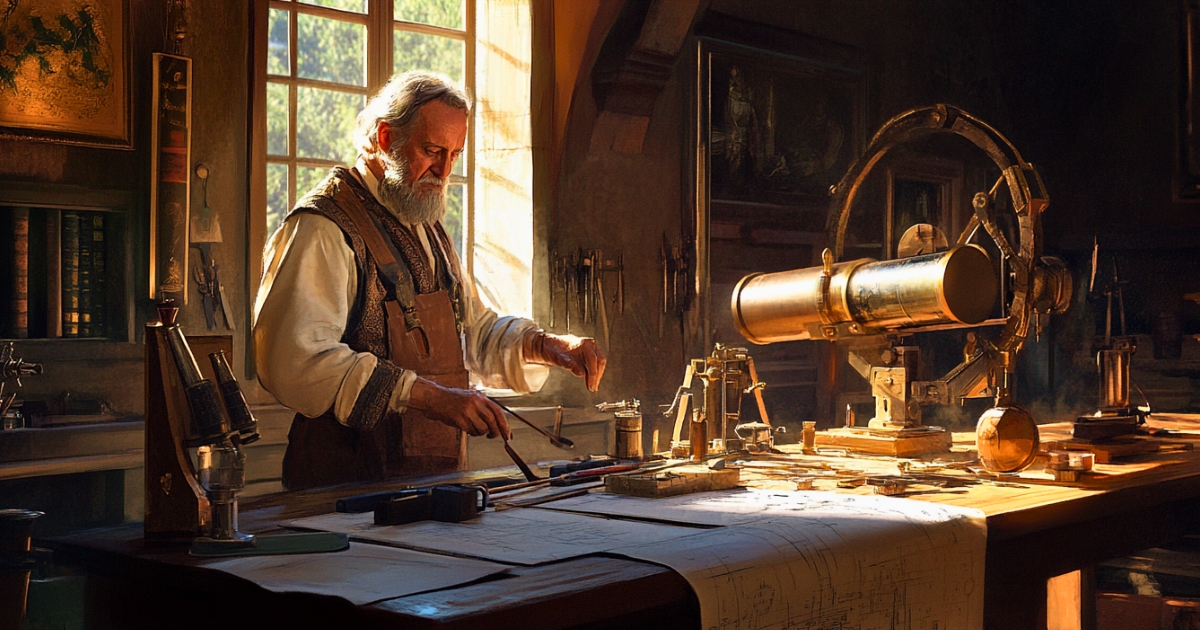Galileo Galilei, who lived during the Italian Renaissance from the late 16th to early 17th century, is renowned as the father of modern science. His name is inextricably linked to revolutionary celestial observations that facilitated the shift from geocentrism (the belief that all celestial bodies revolve around Earth) to heliocentrism (the understanding that Earth and other planets orbit the Sun). Behind these groundbreaking discoveries lay Galileo’s passionate dedication to telescope craftsmanship. This article explores Galileo’s telescope workshop, examining how his artisanal skills contributed to the scientific revolution.
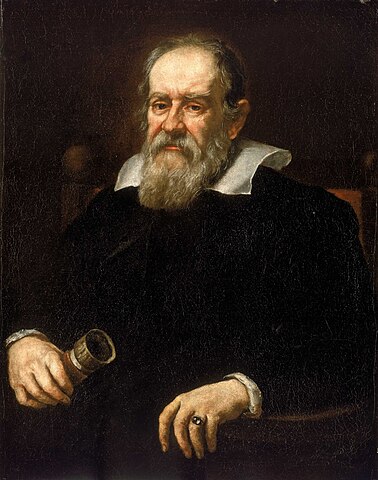
Galileo Galilei (1564-1642): Italian astronomer, physicist, and mathematician
- Galileo’s Encounter with the Telescope
- Establishing the Workshop and Early Experiments
- Innovations in Lens Grinding Techniques
- Telescope Improvements and Performance Enhancement
- Celestial Observations and Shocking Discoveries
- Interactions with Contemporary Craftsmen
- Contributions to the Scientific Revolution
- Challenges and Adversities
- Galileo’s Legacy
- Daily Life in the Telescope Workshop
- The Influence and Spread of Telescope Workshops
- Implications for the Modern Era
- Conclusion
Galileo’s Encounter with the Telescope
Born in Pisa, Italy, in 1564, Galileo showed early promise in mathematics and physics. However, his life took a dramatic turn when he encountered the telescope, invented in the Netherlands in 1608. At the time, telescopes were primarily used for military purposes and navigation, with relatively simple structures.
Galileo saw immense potential in this new invention. He believed that by using the telescope for celestial observations, he could capture views of the universe never before seen by humankind. However, the performance of telescopes at that time was inadequate. This marked the beginning of Galileo’s challenge.
Establishing the Workshop and Early Experiments
In 1609, while serving as a mathematics professor at the University of Padua, Galileo converted a room in his home into a telescope workshop. His goal was to craft higher-performance telescopes himself.
Initially, Galileo studied the structure of existing telescopes to understand their principles. He quickly realized that the quality and arrangement of lenses were crucial to a telescope’s performance. The lenses of that era contained many impurities and distortions, making it difficult to obtain clear images.
Galileo actively engaged with glassmakers and opticians involved in lens production. While learning techniques from them, he applied his mathematical knowledge to design and create more precise lenses.
Innovations in Lens Grinding Techniques
The most critical work in Galileo’s workshop was lens grinding. He improved upon conventional methods, developing more precise grinding techniques.
The process began with selecting high-quality glass materials. Galileo obtained superior glass from Venetian glassmakers. He would roughly shape this glass and then gradually smooth its surface using increasingly fine abrasives.
Galileo meticulously adjusted the grain size of abrasives like sand and iron oxide used at each grinding stage. He also paid close attention to the pressure and movement during grinding to prevent minute scratches or distortions on the lens surface.
Notably, Galileo developed a technique to reduce “spherical aberration.” This phenomenon occurs when light focuses at different points for the center and edges of a lens, causing image blur. Galileo successfully minimized this aberration by subtly altering the curvature between the center and edges of the lens. This technique was revolutionary for its time.
Telescope Improvements and Performance Enhancement
Alongside enhancing lens quality, Galileo also improved the telescope’s structure. Early telescopes had a simple design combining convex (outward-curved) and concave (inward-curved) lenses, but Galileo developed this further.
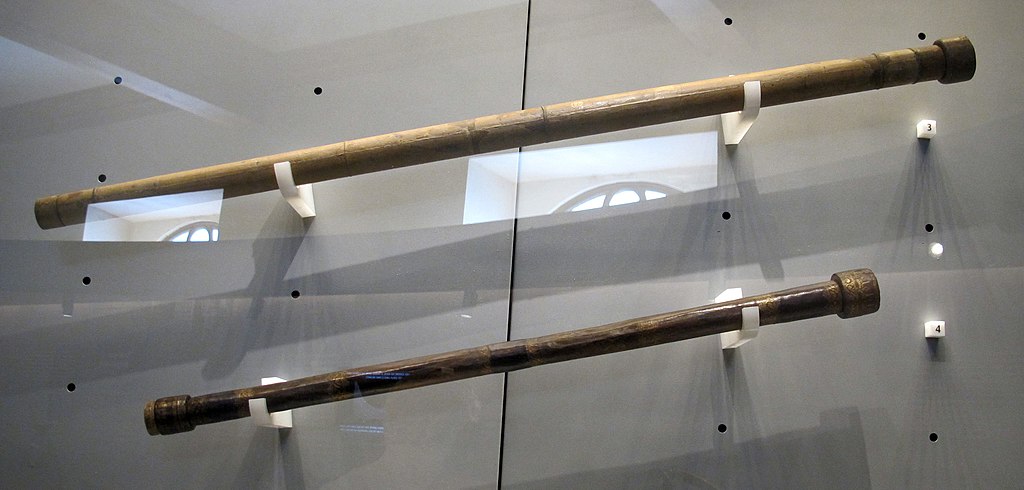
Using these telescopes, Galileo made numerous groundbreaking celestial observations, including lunar craters, Jupiter’s moons, and the phases of Venus. Justus Sustermans, Public domain, via Wikimedia Commons
He made the distance between lenses adjustable, allowing for changes in focal length (the distance from the lens to where the image forms). This enabled adjustment of magnification according to the observational target. He also painted the inside of the telescope tube black to suppress unwanted light reflections, thereby improving contrast.
As a result of Galileo’s efforts, his telescopes achieved remarkable performance. By late 1609, he had succeeded in creating a telescope with about 20x magnification, which was extraordinary for that time.
Celestial Observations and Shocking Discoveries
Armed with his high-performance telescope, Galileo immediately began celestial observations. His findings were shocking, overturning conventional wisdom of the time.
First, he discovered that the Moon’s surface had mountains and valleys. This challenged the ancient Greek belief that celestial bodies were perfect spheres. Next, he discovered four moons orbiting Jupiter (now known as the Galilean moons: Io, Europa, Ganymede, and Callisto). This discovery questioned the geocentric model, which held that all celestial bodies orbited Earth.
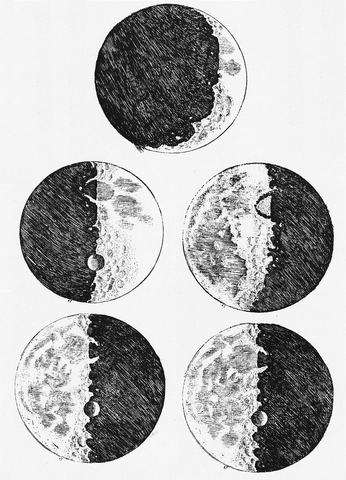
Galileo’s sketches of the Moon. These were the first recorded observations of the Moon through a telescope in human history.
Furthermore, Galileo observed the phases of Venus, asserting this as evidence that Venus orbited the Sun. He also revealed that the Milky Way consisted of countless stars.
These discoveries were published in 1610 as “Sidereus Nuncius” (Starry Messenger), causing a sensation across Europe. Galileo’s telescope had transformed from a mere tool into a revolutionary device unveiling the truths of the universe.
Interactions with Contemporary Craftsmen
Galileo’s success was not solely the result of his individual efforts. He actively engaged with various contemporary craftsmen, absorbing their knowledge and skills.
His interactions with Venetian glassmakers were particularly important. The artisans of Murano Island possessed superior glass manufacturing techniques, from whom Galileo obtained the highest quality glass materials. He also learned their lens shaping techniques.
Exchanges with opticians were equally crucial. The opticians of the time had deep knowledge about the optical properties of lenses. Galileo learned the principles of correcting presbyopia and myopia from them, applying these to his telescope lens designs.
Collaboration with metal workers was also significant. Precise metalworking techniques were necessary for crafting telescope tubes and mounts. Galileo worked with these artisans to design sturdy and user-friendly telescope housings.
Thus, Galileo’s workshop became a place where knowledge and skills from various fields converged. Galileo combined the insights gained from these interactions with his mathematical and physical understanding to produce innovative telescopes.
Contributions to the Scientific Revolution
The role Galileo’s telescope workshop played in the scientific revolution is immeasurable.
Firstly, the development and improvement of the telescope as a new observational tool greatly contributed to establishing empirical scientific methodology. Galileo emphasized data obtained through actual observation rather than relying solely on theory or authority. This became a fundamental attitude of modern science.
Secondly, Galileo’s celestial observations strongly supported Copernicus’s heliocentric theory. In particular, the discovery of Venus’s phases and Jupiter’s moons provided decisive evidence overturning the Earth-centered cosmology. This led to a paradigm shift in our understanding of the universe, significantly influencing subsequent scientific developments.
Furthermore, Galileo’s telescope-making techniques were passed down to later scientists. His precise lens grinding techniques and telescope design principles formed the basis for the development of subsequent optical instruments.
Additionally, Galileo’s workshop activities served as a pioneering example of the close relationship between science and engineering. It demonstrated that new discoveries could be made by combining theoretical knowledge with practical skills. This perspective remains crucial in modern scientific and technological development.
Challenges and Adversities
Galileo’s journey in telescope making was far from smooth. He faced numerous technical and social challenges.
Technically, securing high-quality glass materials was a constant challenge. The glass of that era contained many impurities, making it extremely difficult to create homogeneous lenses. Galileo continuously experimented, facing many failures, in search of optimal materials and processing methods.
Developing precise grinding techniques also required substantial time and effort. Creating lenses free of minute scratches or distortions demanded immense patience and skill. Galileo sometimes spent entire days absorbed in lens grinding.
Socially, Galileo had to contend with criticism and skepticism towards his discoveries. Many contemporaries, especially church officials and traditional scholars, were reluctant to accept Galileo’s observational results. They suspected that Galileo’s telescope might be showing illusions.
To counter this, Galileo conducted public demonstrations to prove his telescope’s capabilities and gifted telescopes to other scientists. However, convincing everyone was no easy task.
As Galileo’s discoveries increasingly conflicted with church doctrine, he faced mounting religious pressure. This ultimately led to his tragic house arrest.
Despite these difficulties, Galileo never gave up. He continued improving his telescopes and conducting celestial observations throughout his life, driven by his pursuit of truth and scientific progress.
Galileo’s Legacy
Galileo Galilei’s telescope workshop is remembered as one of the most important places in the history of science. His efforts and ingenuity not only resulted in a single invention but revolutionized scientific methodology itself.
Galileo’s telescope was further improved by later astronomers, becoming increasingly powerful. In the latter half of the 17th century, Isaac Newton invented the reflecting telescope, enabling observations of even more distant celestial bodies.
Modern giant telescopes and space telescopes are the result of long technological evolution that began in Galileo’s small workshop. The tradition of observational astronomy he initiated continues to thrive in observatories worldwide today.
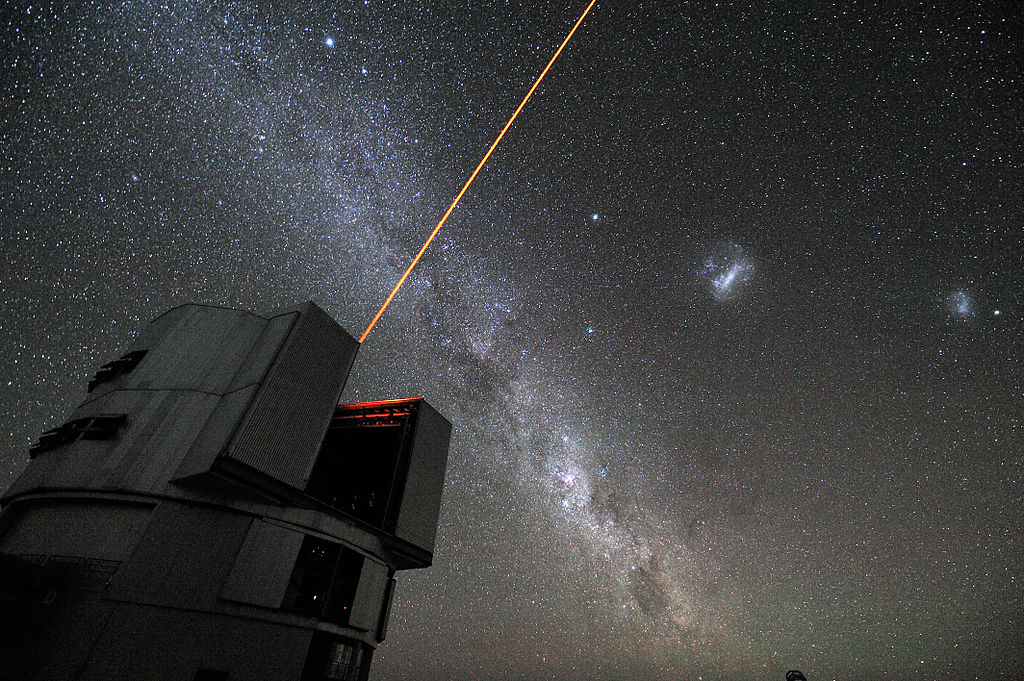
The Yepun telescope of the Very Large Telescope (VLT) in Chile’s Atacama Desert. The technological advancements that began with Galileo’s telescope have made such modern giant telescopes possible. G. Hüdepohl/ESO, CC BY 4.0, via Wikimedia Commons
Moreover, Galileo’s empirical approach (verifying theories based on actual observations and experiments) became established as a fundamental scientific methodology. The basic scientific process of formulating and testing hypotheses based on observation and experimentation was established in Galileo’s era.
Galileo’s activities also demonstrated the importance of integrating science and technology. In his workshop, theoretical knowledge and practical skills were closely intertwined. This attitude resonates with modern scientific and technological research and development.
Galileo’s telescope workshop also marked a starting point for the democratization of science. He gifted his handmade telescopes to other scholars and sought to widely share his discoveries. This spread the idea that scientific knowledge was not the exclusive domain of specific authorities, but that anyone could reach the truth through observation and verification.
Today, Galileo’s spirit lives on in citizen science (scientific research activities involving the general public) and science education. Many astronomy enthusiasts observe the night sky with self-made telescopes, experiencing the same joy and wonder as professional astronomers. This, too, is part of the tradition Galileo started.
Daily Life in the Telescope Workshop
What was daily life like in Galileo’s telescope workshop? Let’s imagine the scene based on remaining records and testimonies from contemporaries.
The workshop was set up in a room of Galileo’s home. A large workbench stood in the center of the room, covered with various tools and parts. Completed telescopes and experimental equipment were likely placed near the windows.
Galileo’s day began early in the morning. As he often conducted celestial observations late into the night, he might have risen a bit later in the morning. After breakfast, he would enter the workshop to organize the previous night’s observational results, formulate new hypotheses, or consider improvements for his telescopes.
Mornings were primarily devoted to lens grinding. This was an extremely delicate process, and Galileo would concentrate on it for hours. Sometimes assistants or apprentices would help, but Galileo himself performed the most critical processes.
In the afternoon, Galileo would incorporate the completed lenses into telescopes and conduct tests. On clear days, he would observe distant buildings or mountains to confirm performance. He also used this time for meetings with other scientists and craftsmen.
In the evening, Galileo would begin preparations for observations. He would carry the telescope outdoors and search for the optimal observation point. While waiting for the sun to set, he might have given astronomy lectures to his apprentices.
As night fell, full-scale observations would begin. Galileo would spend hours battling the cold, observing the moon, planets, and stars, and making detailed sketches. On nights of particularly important discoveries, he might have been too excited to sleep until morning.
It was the accumulation of such daily efforts that led to Galileo’s great discoveries.
The Influence and Spread of Telescope Workshops
The success of Galileo’s telescope workshop spread throughout Europe, inspiring many imitators and competitors.
In Italy, Galileo’s disciples learned their master’s techniques and established their own workshops. Particularly in Venice, the telescope industry developed in combination with high-quality glass manufacturing techniques.
In the Netherlands, proud of being the birthplace of the telescope, further improvements were made. Christiaan Huygens developed a more powerful telescope based on Galileo’s techniques and discovered Saturn’s rings.
In England, Robert Hooke and Isaac Newton worked on improving telescopes. Newton’s invention of the reflecting telescope, in particular, was groundbreaking, overcoming the limitations of Galileo-type telescopes.
In France, Giovanni Cassini constructed giant refracting telescopes (telescopes that use lenses to collect light) and discovered several of Saturn’s moons.
Thus, Galileo’s workshop spread telescope-making fever throughout Europe, significantly contributing to the advancement of astronomy.
Implications for the Modern Era
The story of Galileo’s telescope workshop offers many insights for us today.
- Importance of Innovation: Galileo didn’t merely imitate existing technology but constantly sought improvements and innovations. This attitude remains crucial in modern scientific and technological research and development.
- Interdisciplinary Approach: Galileo integrated knowledge from various fields including mathematics, physics, engineering, and astronomy to develop his telescopes. This interdisciplinary approach (tackling problems by crossing multiple academic disciplines) is essential in solving complex problems in the modern world.
- Fusion of Theory and Practice: Galileo achieved significant results by combining theoretical knowledge with practical skills. In modern research and development, close collaboration between basic research and applied research is crucial.
- Importance of Observation: Galileo emphasized actual observation and built theories based on it. This empirical approach has become a fundamental methodology in modern science.
- Challenge and Perseverance: Galileo never gave up despite facing technical difficulties and social opposition. Such tenacity is necessary in the process of innovation.
- Knowledge Sharing: Galileo sought to widely share his discoveries. In the modern era, the importance of open science (initiatives to make research processes and results widely accessible) and open innovation (creating new value by sharing knowledge and technology beyond organizational boundaries) is recognized.
- Curiosity and Creativity: At the core of Galileo’s success were his deep curiosity about the mysteries of the universe and his creativity in trying to unravel them. These elements are essential for the development of science and technology.
Conclusion
Galileo Galilei’s telescope workshop was a symbolic place of the scientific revolution. It was where craftsmanship merged with scientific insight, leading to discoveries that fundamentally changed humanity’s view of the universe.
Galileo’s telescope was more than just an observational tool. It embodied an empirical scientific methodology and represented a new approach to knowledge that prioritized observation over authority.
His daily efforts and ingenuity in the workshop continue to influence scientists to this day. Modern giant telescopes and space telescopes are extensions of the exploration Galileo began.
At the same time, Galileo’s story teaches us about the difficulties innovative ideas face before gaining social acceptance. His experience demonstrates the importance of courage and perseverance in overcoming the friction that arises when new discoveries or theories clash with existing worldviews.
Today, we take for granted astonishing images of the universe and the latest scientific discoveries. However, at their foundation lies the lens that Galileo polished in his workshop over 400 years ago and the revolutionary observations that resulted from it.
The story of Galileo’s telescope workshop teaches us that scientific and technological progress is achieved through individual passion and creativity, as well as cooperation across society. It not only shows respect for great scientists of the past but also calls us to our responsibility towards future scientific and technological development.
